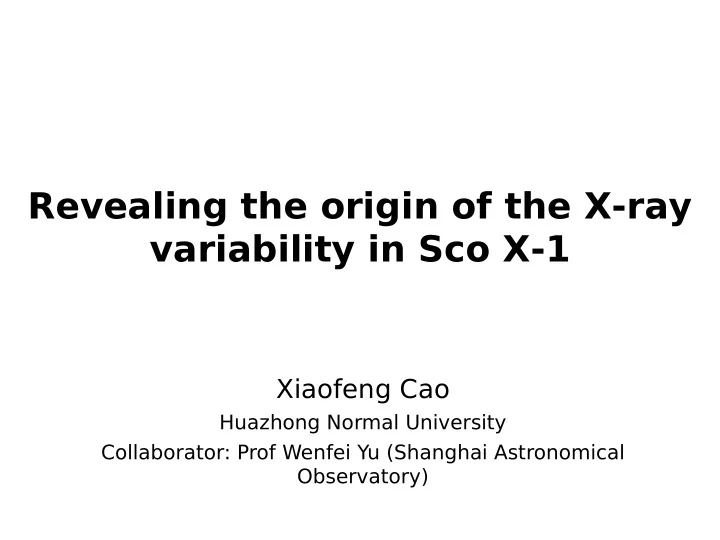

Revealing the origin of the X-ray variability in Sco X-1 Xiaofeng Cao Huazhong Normal University Collaborator: Prof Wenfei Yu (Shanghai Astronomical Observatory)
Outline •X-ray Variability in NS LMXBs •Revealing the origin of the variability •Discussion and conclusion
Spectral and Timing properties color-color diagram power density spectra VLFN HBO Dieters & van der Klis 2000 van der Klis & Wijnands 1997 VLFN : Very Low Frequency Noise BLN : Band-Limited Noise HBO : Horizontal Branch Oscillation N/FBO : Normal/Flaring-Branch Oscillation KHz QPO : kilohertz Quasi-Periodic Oscillation
Z sources compared with other LMXBs Belloni et al. 2002 Wijnands & van der Klis 1996 Psaltis et al. 1996 filled circles: black-hole candidates open circles: Z sources crosses: atoll sources van der Klis 2006 These relations suggest similar origins of BLN etc. across LMXBs .
“parallel-track” phenomena Méndez et al. 1999 Ford et al. 2000 On the time scale of hours corresponding to each track, the frequency of the kHz QPOs is believed to correlate with the mass accretion rate. On longer timescales, and across sources, the relation between kHz QPO frequency and luminosity is lost.
The idea • Study the kHz QPO frequency variation on the coherence timescale of a certain variability component at a lower frequency. For example, study the correlation between the X-ray flux on the timescale of a certain variability component and the kHz QPO frequency. • Compare the correlation with that corresponding to the “parallel-tracks” In this way, we reveal the clues to the origin of the X- ray variability of Sco X-1, therefore the origins of the same components across LMXBs.
Why Sco X-1 ? • the brightest persistent X-ray source Variability components generally have similar fractional rms amplitude among sources on the same state. The best sources for the study of a certain variability component are the brightest sources.
X-ray Variability on long and short time scales 1. Hundreds of seconds -- VLFN • There is an anti-correction between the kHz QPO frequency and the VLFN flux. • The VLFN is primarily associated with the variation of the mass accretion rate, which is associated with the variation on each parallel track. Yu et al. 2001
2. Seconds -- BLN • Both lower( ) and upper( ) kHz QPO frequency are positively correlated with the BLN flux. • On the BLN timescales the peak separation ( ) decreases by about 2~4 Hz with increasing , consistent with that on long time scales the source traces on the color-color diagram. • The BLN is likely associated with the disk flux. Cao & Yu 2009
3. A hundred milliseconds -- NBO • The frequency of the upper kHz QPO is anti-correlated with the NBO flux. • • The NBO flux probably originates from inside the inner disk radius, which exerts a radiative stress on the inner disk edge causing orbital frequency modulation. • • Failure of the unknown mechanism for the kHz QPOs to generate the lower kHz QPO during Yu et al. 2001 the NBO phase of high flux.
4. Ten milliseconds -- HBO • The HBO shows up during the NBO phase of high flux. • Investigation of the variability on the coherence time scale of HBO is underway. filled circles: high flux crosses: low flux Yu 2007
Discussion and conclusion • We have systematically studied the X-ray variability in neutron star LMXBs from hundreds of seconds to ten milliseconds. • Comparing the correlation behavior with the that of the variation forming each parallel track, we provide the evidence that: BLN corresponds to the variation of the mass accretion rate in the disk flow NBO flux is generated inside the inner disk or on the neutron star surface HBO shows strong coupling with the NBO ● Assuming the unified picture of neutron star and black hole variability is correct, the BLN in black hole binaries corresponds to the variation of the mass accretion rate in the disk flow (not from corona, radial flow, or jet).
Thanks !
Recommend
More recommend